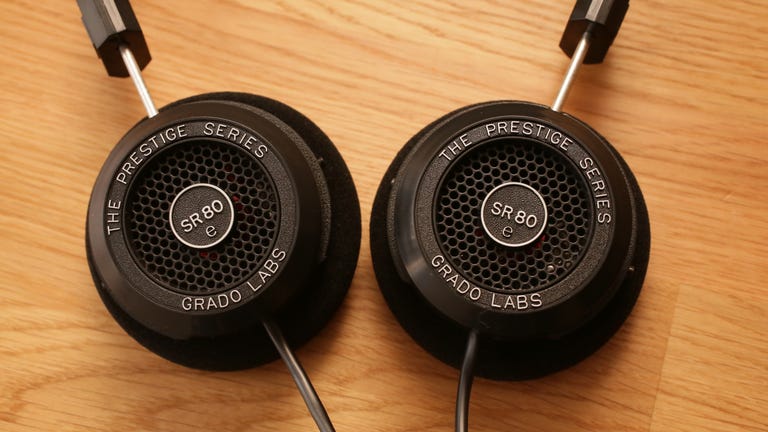 Why You Can Trust CNET
Why You Can Trust CNET Grado Prestige Series SR80e review: Strikingly good sound for less than $100
If you don't need the isolation of a closed-back design or a built-in microphone for cell phone calls, the SR80e is a great headphone for the money.
This is the SR80e, Grado's next-gen version of its SR80 Prestige Series on-ear open-back headphone. It replaces the SR80i and at $99 (£99.95 in the UK,AU$179.00 in Australia), it's easily among the best-sounding headphones you can get for under $100 USD.
The Good
The Bad
The Bottom Line
Grado has not changed the exterior design of the headphone from its predecessors, so -- for an on-ear style headphone -- it's quite comfortable and relatively lightweight. In fact, we found the SR80e's black foam pads more comfortable than the $295 USD SR325e's "bowl" pads, which apply more pressure to the outer edges of your ears.
Our only complaint about the design is the plug. It's very sturdy but with more people using their smartphones as music-playback devices, Grado would have ideally made it more case-friendly. As it is, it's so beefy that if your case ends up recessing your smartphone's headphone jack -- even by half a millimeter -- you just won't be able to plug the headphone in. (Yes, you can buy an adapter dongle, but you shouldn't have to in this day and age.)
As far as extras go, there really aren't any. You do get a 6.33mm (1/4-inch) jack converter for plugging into a home stereo system, but that's it. No case, no inline remote of microphone. Grado remains true to its no-frills audiophile roots, and it's worth noting that every Grado headphone -- even higher-end models -- still come in very simple "cheap" packaging, which is refreshing.
It's also worth mentioning that the SR80E, like most of Grado's phono cartridges and higher-end headphones, is still assembled by hand in the company's Brooklyn, New York facility.
Performance
Grado didn't totally change the sound for the new e Series, but the SR80e is a definite upgrade from the previous "i" Series' sound. The model is more laid-back, and the bass is fuller and deeper. That adds up to a smoother tonal balance than before, so when we compared the SR80e with the older but more expensive SR225i, the SR80e's sweeter sound had plenty of detail, along with deeper and more powerful bass. We also noted that we could listen to the SR80e at fairly quiet volume levels without losing much detail.
On the outside, the heapdhones haven't changed, but what's inside has.
The Sony MDR-7506 is one of our favorite $100 headphones, but it flattened dynamics and coarsened the treble, compared to the SR80e. With the Grado dynamics kicked harder, so the music felt more alive, while the MDR 7506 put a lid on the energy. Also, the MDR 7506 is a closed-back design, so its stereo imaging sounded a little cramped next to the wide-open SR80e.
Audio Technica's ATH-M50x headphones make more bass, but thanks to the SR80e's open-back design, its stereo imaging was more spacious and natural sounding than the closed-back ATH-50x. The biggest downside to open-back designs is they don't block external noise (and also leak sound), so the SR80e won't be ideal for travelers or anyone who listens in noisy environments.
The headphone cord and plug are thick and sturdy, but the plug isn't compatible with many smartphone cases.
Conclusion
We've long been fans of Grado headphones and are really impressed by the quality of sound you get from this new $100 model. If you don't need the isolation of a closed-back design or a built-in microphone for cell phone calls, it's a great headphone for the money.




